
Fiber converters are often part of that setup. They help you run data over long distances without losing quality. But here’s the thing: not all fiber converters are made with LED screens in mind.
Some are built for general networking. Others, like the NovaStar fiber converter, are designed specifically for LED control systems. They’re better at handling video signals, resisting interference, and staying stable during long runs.
This article looks at what makes NovaStar converters different from regular ones and how to choose the right one for your display. LedInCloud – LED Screen Cloud Platform will provide you with the most comprehensive information.
1. What Is a Fiber Converter?
A fiber converter lets you send data over long distances using fiber optic cables. It takes a standard electrical signal—like the one from your LED sending card—and converts it into an optical signal. At the other end, another converter changes it back to electrical. That’s the basic idea.
In most LED screen setups, the control room isn’t always close to the display. It could be on the other side of the stadium or a few floors away. Regular Ethernet cables won’t go far. After 100 meters, they lose speed, stability, and often fail. That’s where fiber comes in.
Fiber optic cables can send data much farther – hundreds or even thousands of meters. And they do it faster and with less interference. But to use them, you need a fiber converter on both ends.
In an LED system, one fiber converter usually connects to your sending card or video controller, and the other sits near the receiving cards behind the screen. Between them runs the fiber optic cable.
There are two types of fiber:
- Single-mode fiber: Supports longer distances, up to 20 km. Often used in outdoor or large venue setups.
- Multi-mode fiber: Better for shorter runs, usually under 500 meters. Often used indoors.
Both types need matching hardware. That’s why LED control brands like NovaStar make their own fiber converters. These are designed specifically for LED video signals – not general internet traffic. That difference matters more than most people realize.
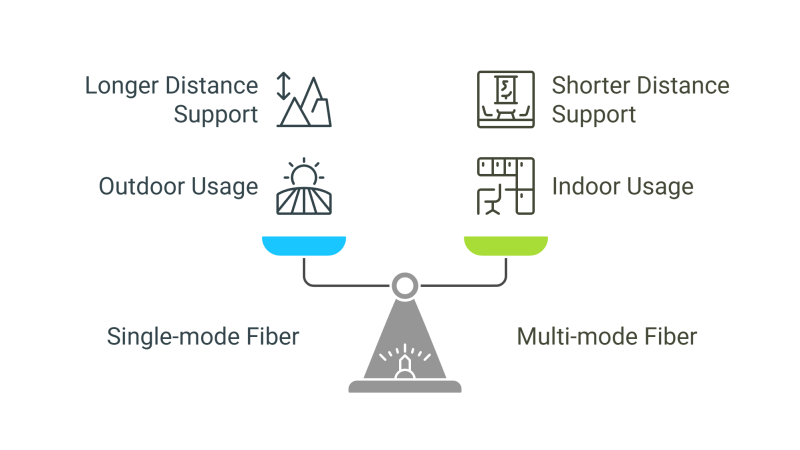
2. Core Differences: NovaStar Fiber Converter vs Regular One
At first glance, a fiber converter looks like a basic tool. Plug it in, connect the cable, done. But when you’re working with LED displays, especially for video, not all converters can handle the job.
Here’s how a NovaStar fiber converter stands apart from a regular one:
2.1 Built for LED Displays
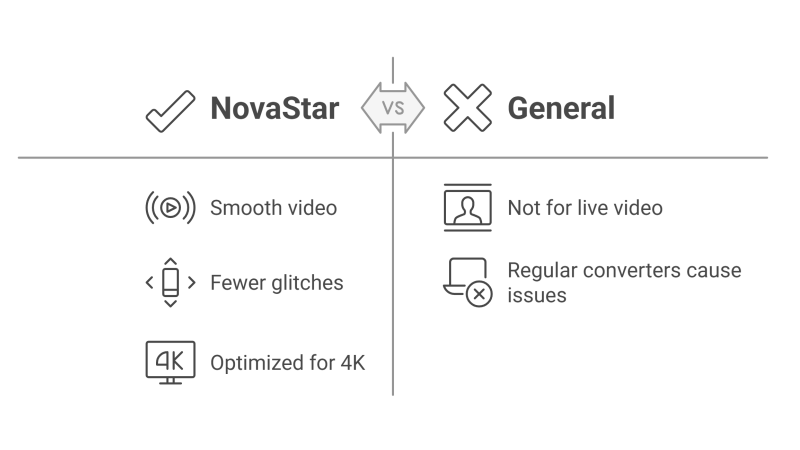
Most generic fiber converters are designed for network traffic—file transfers, emails, office systems. They’re not made for live video signals.
NovaStar converters are different. They’re built for LED control systems. That means smoother frame syncing, better color consistency, and fewer glitches during long shows or broadcasts.
When you’re running video content, especially 4K or high refresh rate material, this matters. A drop in data might not crash your screen – but it can cause flicker, delay, or screen tearing. A regular converter simply isn’t optimized to prevent that.
2.2 Stable Over Long Distances
NovaStar converters like the CVT320 support single-mode fiber. That gives you up to 20 kilometers of transmission without losing quality.
Most basic fiber converters can’t go nearly that far, or they lose signal strength over time. You might get 500 meters, maybe a kilometer or two—but that’s pushing it, especially with video data.
If your control room is far from the screen, or you’re working across buildings, you need a converter built for long runs. This is where Nova CVT320 really shows its strength.
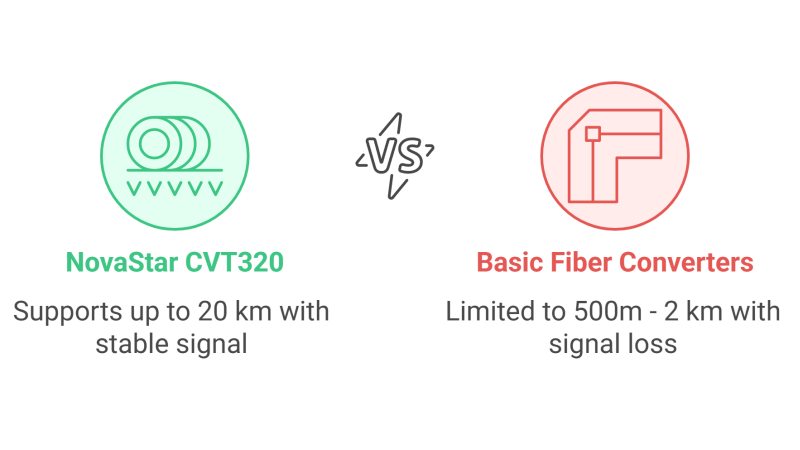
2.3 Designed to Work with NovaStar Systems
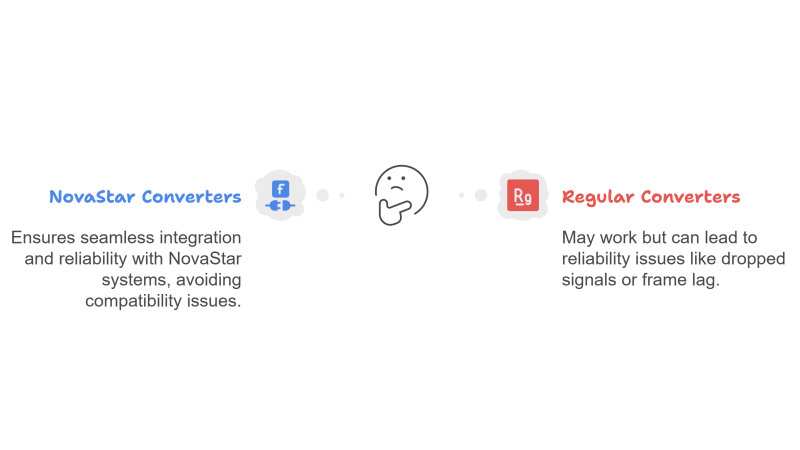
This may sound obvious, but it’s often overlooked. NovaStar converters are made to integrate smoothly with NovaStar sending cards, processors, and receiving systems. No setup headaches. No compatibility issues.
Regular converters might still “work”—but not always reliably. Some users report dropped signals or frame lag when trying to mix hardware from different brands. That’s risky when you’re managing a live event or a large-scale LED wall.
Models like CVT10 NovaStar or NovaStar CVT4K S fiber converter are made to plug straight into NovaPro UHD, H series, or MCTRL series without tweaks. That’s not just convenient—it’s reliable.
2.4 Better Handling of Interference
LED displays often run in messy environments. Think outdoor billboards with traffic power lines nearby, or stadiums full of AV equipment and wireless signals.
NovaStar converters are built to deal with it. Their shielding and internal components are designed for high-noise, high-demand situations. Regular converters? Not so much. In a clean lab, they work fine. In the field, things get less predictable.
If you’ve ever seen a screen flicker during a concert or sports game, poor signal shielding might be to blame.
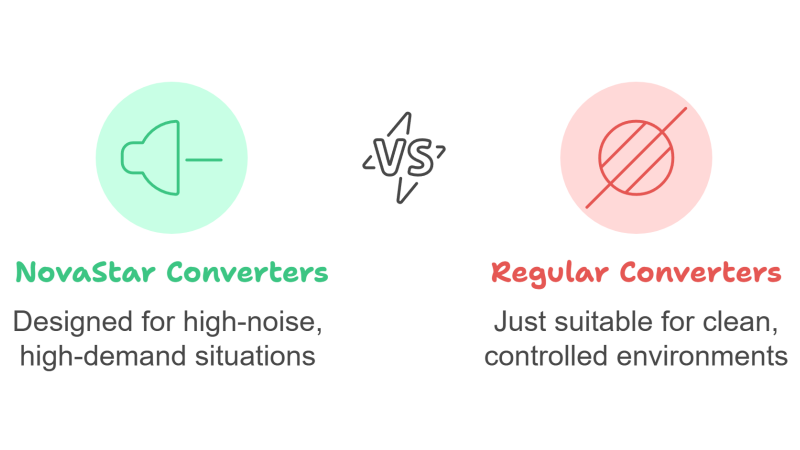
2.5 Real Support, Real Specs
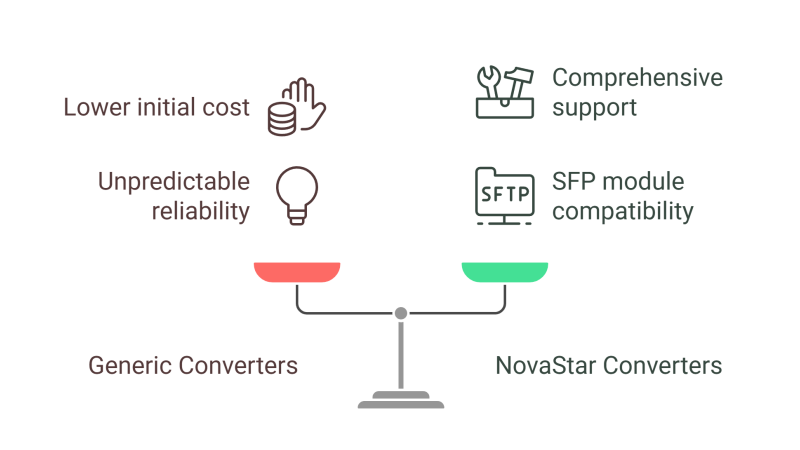
Generic converters are usually made for price. They work until they don’t. If something goes wrong, there’s not much documentation or support.
NovaStar converters, on the other hand, come with detailed specs, SFP module compatibility, and firmware support. You can match them to your LED project with confidence.
2.6 Quick Comparison
| Feature | Novastar Fiber Converter | Regular Fiber Converter |
| Designed for LED Displays | ✅ Yes, optimized for video signals | ❌ No, made for general data transfer |
| Transmission Distance | Up to 20km (e.g. CVT320, single-mode) | Usually under 2km |
| Compatibility | Seamless with Nova sending cards & systems | May have signal or sync issues |
| Signal Stability | High-designed for real-time video | Medium-may drop under pressure |
| Anti-Interference | Strong-built for noisy environments | Limited resistance |
| Supports 4K Video | ✅ Yes (e.g. CVT4K-S, CVT4K-M) | ❌ Rarely supports high-bandwidth video |
| Setup & Integration | Plug-and-play with Nova hardware | May require adjustments |
| Support & Documentation | Complete specs, firmware support | Often minimal |
3. NovaStar CVT Series Models Comparison
The NovaStar CVT series fiber converters by NovaStar Technology cater to diverse signal transmission needs for LED displays. Below is a detailed comparison of key specifications across models:
3.1 Comparison Table
| Model | NovaStar CVT4K-S | NovaStar CVT4K-M | NovaStar CVT320 | NovaStar CVT310 | NovaStar CVT10-S/M | NovaStar CVT10 Pro-S/M |
| Fiber Type | Single-mode | Multi-mode | Single-mode | Multi-mode | Single-mode (S) Multi-mode (M) | Single-mode (S) Multi-mode (M) |
| Optical Ports | 4× LC (Twin-core) | 4× LC (Twin-core) | 1× LC (Twin-core) | 1× LC (Twin-core) | 2× LC (Twin-core) | 2× LC (Twin-core) |
| Ethernet Ports | 16× Neutrik | 16× Neutrik | 1× Gigabit | 1× Gigabit | 10× Gigabit | 10× Gigabit |
| Wavelength | 1310 nm | 850 nm | 1310 nm | 850 nm | 1310 nm (S) 850 nm (M) | 1310 nm (S) 850 nm (M) |
| Max Distance | 10 km | 300 m | 20 km | 550 m | 10 km (S) 300 m (M) | 10 km (S) 300 m (M) |
| Data Rate | 9.95-11.3 Gb/s | 9.95-11.3 Gb/s | 1.25 Gb/s | 1.25 Gb/s | 9.95-11.3 Gb/s | 9.95-11.3 Gb/s |
| Power (Rated) | 21 W | 21 W | 3.5 W | 3.5 W | 18 W | 22 W |
| Dimensions (mm) | 482.6×377.0×96.0 | 482.6×377.0×96.0 | 149.0×135.0×38.0 | 149.0×135.0×38.0 | 254.3×50.6×290.0 | 482.6×88.1×280.0 |
| Redundancy | Dual power OPT3/4 backup | Dual power OPT3/4 backup | – | – | OPT2 backup port | OPT2 backup port |
| Key Features | Dual control ports | Dual control ports | Compact design | Compact design | Modular rack-mount | Dust/waterproof Truss-mountable |
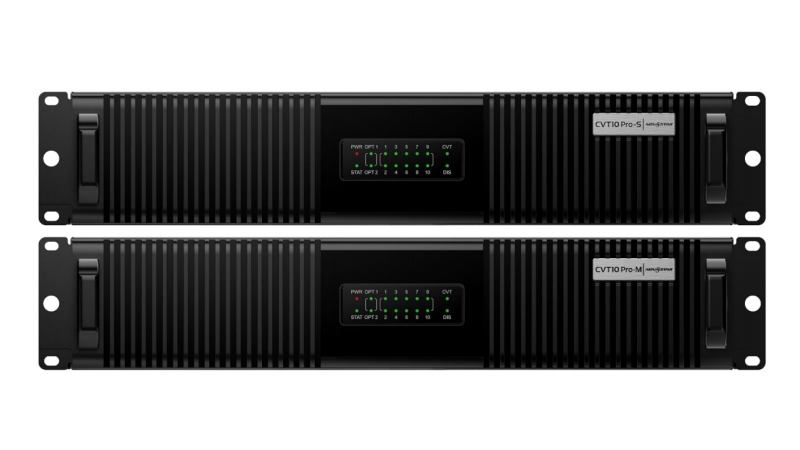
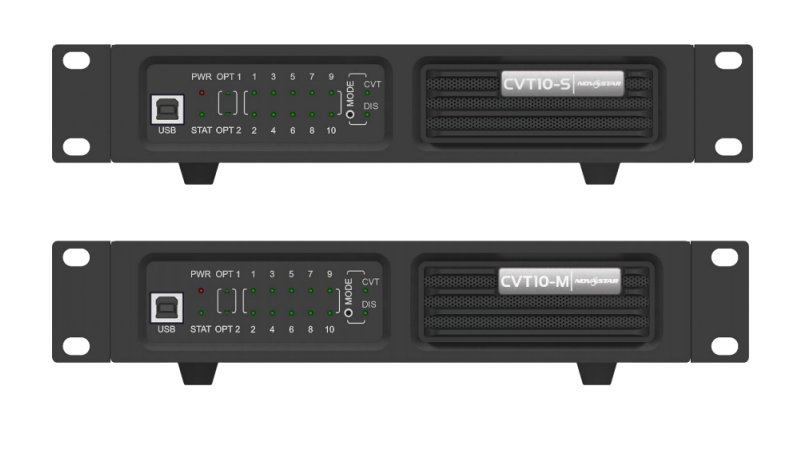
3.2 Recommended Use Cases
| Model | Best For |
| CVT4K-S/M | Stadiums, control rooms requiring high bandwidth and redundancy. |
| CVT10 Pro-S/M | Outdoor events, harsh environments (e.g., concerts, construction sites). |
| CVT10-S/M | Touring events, space-constrained racks. |
| CVT320 | Long-distance single-link transmission (e.g., highway signs). |
| CVT310 | Indoor LED screen with ≤550 m fiber runs. |
4. Where NovaStar Fiber Converters Work Best?
NovaStar CVT series fiber converters excel in distinct operational environments, leveraging specialized designs to address specific industry demands:
4.1 Large Fixed Installations
For permanent high-density deployments like stadiums, broadcast studios, and control rooms, NovaStar CVT4K-S/M series is ideal. Its 16 Neutrik Ethernet ports and 4 optical ports (with OPT3/4 redundancy) ensure robust signal distribution across massive LED walls. Single-mode variants (CVT4K-S) support transmissions up to 10 km, making them suitable for linking remote displays to central control hubs. Dual power inputs and hot-swappable modules further guarantee uninterrupted operation in 24/7 critical environments.
4.2 Mobile & Temporary Events
Touring concerts, exhibitions, and outdoor festivals benefit most from the NovaStar CVT10 Pro-S/M and CVT10-S/M. The CVT10 Pro’s dustproof/waterproof construction and truss-mount capability (using φ10mm bolts) withstand harsh stage environments like rain, dust, or vibration. Meanwhile, the compact CVT10 series offers modular flexibility: its half-1U width allows two units (or one unit with a connector) to form a 1U rack assembly, enabling rapid setup and teardown for time-sensitive events. Multi-mode variants (CVT10-M/CVT10 Pro-M) efficiently handle short fiber runs (≤300 m) between booths or stages.

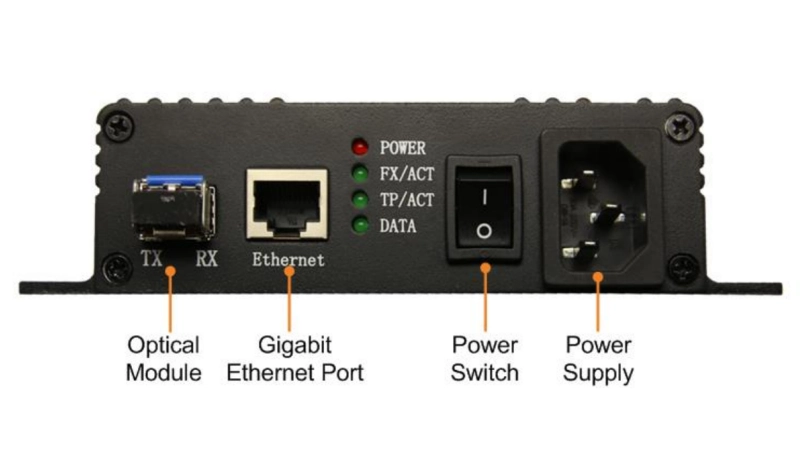
4.3 Long-Distance Infrastructure
Applications requiring extended signal reach—such as highway signs, airport displays, or industrial campuses—rely on the NovaStar CVT320 (single-mode) and NovaStar CVT310 (multi-mode). The CVT320 achieves 20 km transmissions over single-mode fiber, ideal for connecting remote infrastructure where cabling spans kilometers. For mid-range needs (≤550 m), the cost-effective NovaStar CVT310 uses multi-mode fiber to link factory-floor screens to control rooms. Both models’ minimal footprint (149 × 135 × 38 mm) facilitates installation in tight electrical enclosures or roadside cabinets.
4.4 Challenging Environments
NovaStar CVT10 Pro-S/M dominates in extreme conditions. Its industrial-grade design combats dust, moisture, and temperature fluctuations (–20°C to +55°C), making it indispensable for construction sites, mining operations, and coastal installations. Corrosion-resistant connectors and conformal-coated PCBs ensure longevity in high-humidity or saline environments, while KC/UL certifications validate compliance in regulated markets like Korea and North America.
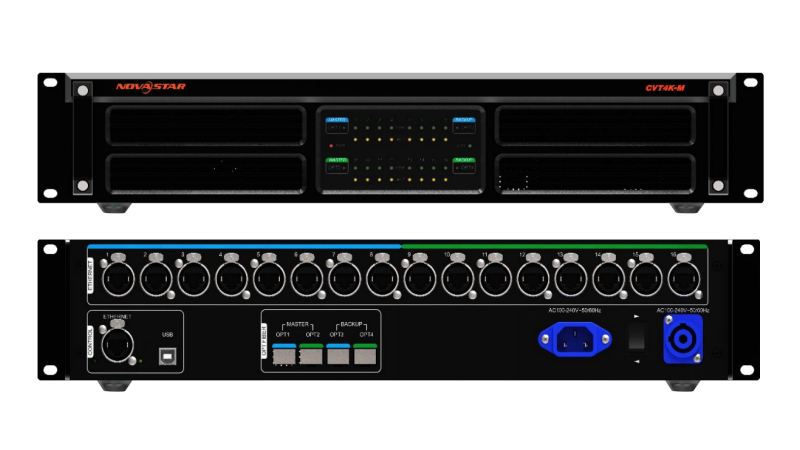
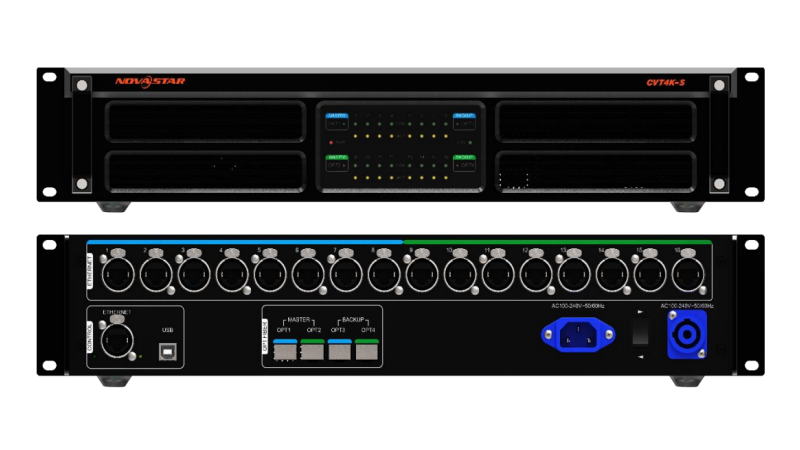
5. FAQs About NovaStar Fiber Converters
How do I choose between CVT4K and CVT10 Pro for large events?
The CVT4K series (16 Ethernet ports) suits ultra-high-density deployments like stadium control rooms, where redundant power and optical backups (OPT3/OPT4) are critical. For outdoor stages or harsh environments (e.g., concerts with rain/dust), the CVT10 Pro is mandatory—its IP-rated dust/water resistance and truss-mount design (using φ10mm bolts) ensure reliability.
Can I mix single-mode and multi-mode converters in one setup?
No. Single-mode (1310 nm) and multi-mode (850 nm) fibers are incompatible due to differing core diameters and light dispersion. Always use the same fiber type end-to-end (e.g., pair CVT320 [single-mode] with CVT4K-S, or CVT310 [multi-mode] with CVT10 Pro-M).
Do NovaStar converters support daisy-chaining?
Only CVT4K and CVT10 Pro offer limited cascading:
- Use OPT3/OPT4 backup ports (CVT4K) or OPT2 (CVT10 Pro) for failover links.
- Ethernet/USB ports are not for cascading; they connect solely to control computers.
Why is my CVT310’s transmission unstable beyond 300m?
The CVT310 (multi-mode) has a 550m max range, but signal integrity degrades near limits. Check:
- Fiber quality (use OM3/OM4-certified cables).
- Bend radius (≥10× cable diameter).
- Connector cleanliness (dust caps when unused).
- For >550m runs, switch to single-mode models (e.g., CVT320, 20km range).
6. Conclusion: Choose Smart for Your LED Display
When it comes to LED displays, signal transmission is more than just a technical detail—it’s the backbone of your system. A weak link in the transmission chain can cause flickering, sync problems, or even total signal loss. That’s why your choice of fiber converter matters.
Generic fiber converters might work in ideal conditions. But LED displays rarely operate in ideal conditions. They run in stadiums, city centers, live stages, and production rooms—places where timing, clarity, and stability make a visible difference.
Novastar fiber converters—like the CVT320, CVT10, and CVT4K-S—are built for these challenges. They support longer distances, handle higher bandwidth, and integrate perfectly with Nova controllers and processors.
If your LED screen is just a few meters from the control box and only showing static content, a basic converter might be enough. But if you’re managing video walls, 4K content, or live shows—don’t cut corners. Choose a converter that’s made for the job.
Any questions, please contact LedInCloud.
